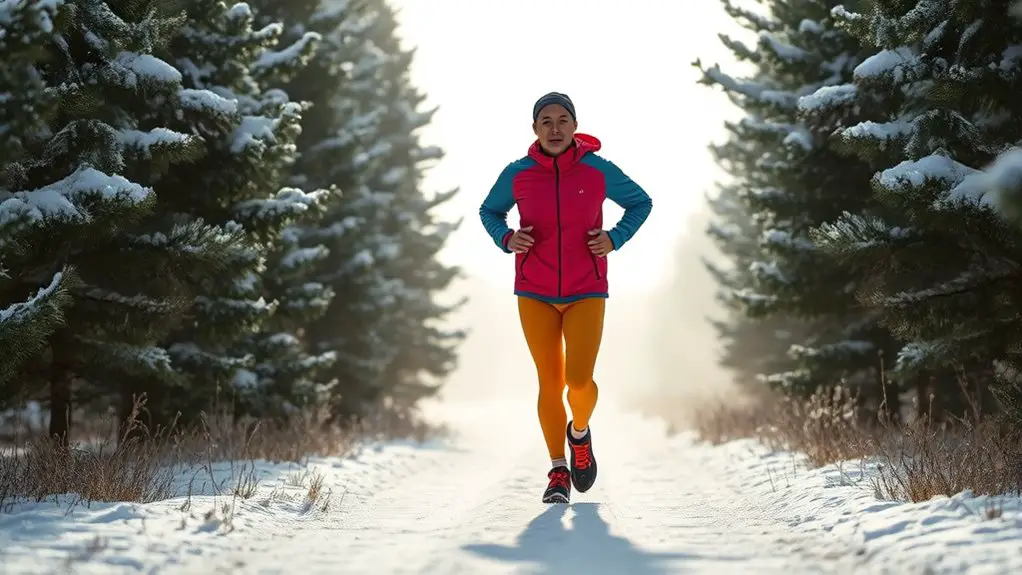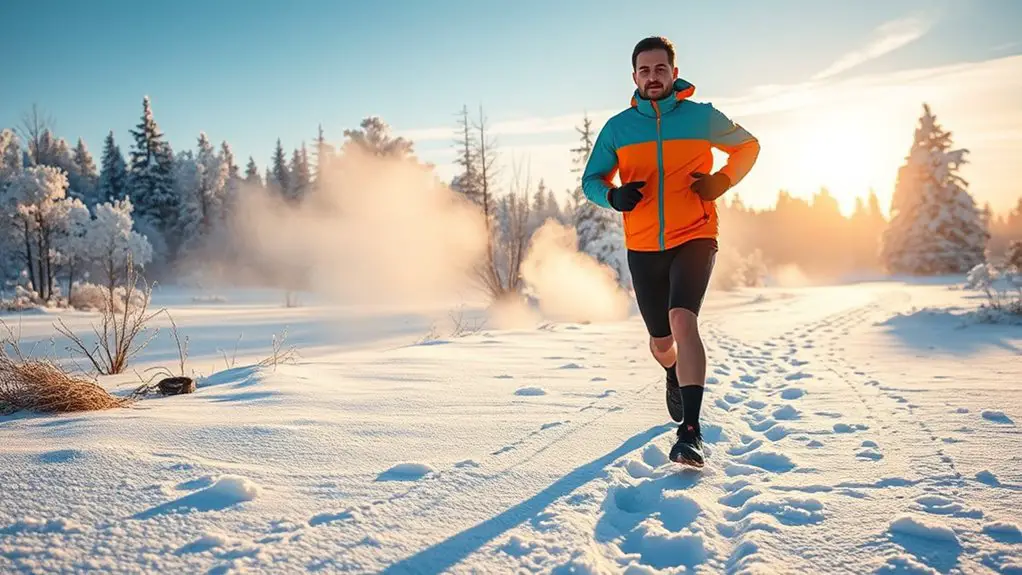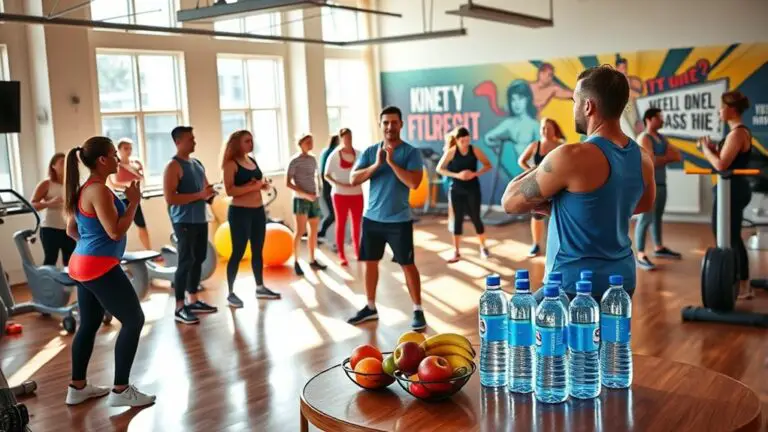How to Stay Motivated to Train in the Cold Weather

To stay motivated for training in cold weather, embrace the unique benefits of winter workouts, like improved stamina and boosted mood. Dress in layers that manage moisture to keep comfortable. Set realistic goals and track your progress to stay engaged. Create a consistent schedule and consider finding a training buddy for accountability. Don’t forget to explore indoor alternatives to stay active when it’s too cold outside. There are plenty of effective strategies to keep you inspired throughout the season.
Embrace the Cold: Understanding the Benefits of Winter Training

When you embrace the cold, you might discover that winter training offers unique benefits that can enhance your fitness journey. One of the main winter benefits is the boost in cold endurance. Your body adapts to lower temperatures, improving your overall stamina and resilience. This adaptation helps you perform better in warmer conditions, making summer workouts feel easier.
Additionally, winter training can elevate your mood. The crisp air and serene landscapes provide a revitalizing change of scenery, keeping your motivation high. You’re also likely to encounter fewer crowds, allowing for a more focused workout.
Moreover, the colder months can strengthen your immune system, as regular exercise promotes better overall health. Incorporating activities like skipping rope can enhance your workout routine, making it both effective and enjoyable. So, don’t shy away from the chill; instead, use it as an opportunity to challenge yourself and grow stronger. Embrace winter training, and you’ll find that the cold can be your ally, not your enemy.
Dress for Success: Choosing the Right Gear
Embracing the cold is just the first step; having the right gear is what truly sets you up for success in winter training. Start with layering techniques: a moisture-wicking base layer helps keep sweat away from your skin, while an insulating mid-layer traps warmth. Finally, choose a weather-resistant outer layer to shield yourself from wind and precipitation.
Moisture management is key during winter workouts. Even in the cold, you’ll sweat; if that moisture isn’t managed well, you risk getting chilled. Look for fabrics designed to wick away moisture and dry quickly. Don’t forget accessories like gloves, hats, and thermal socks, as these can make a huge difference in your comfort level.
Set Realistic Goals: Adjusting Your Training Expectations

As the temperature drops, it’s essential to adjust your training expectations to stay motivated and avoid burnout. Setting realistic goals during colder months can help you maintain your enthusiasm and commitment. Instead of aiming for long runs or intense workouts, consider shorter, more manageable sessions that fit the weather conditions.
Focus on goal setting that emphasizes consistency rather than intensity. For example, committing to three workouts a week, even if they’re at a lower intensity, can keep you engaged and moving forward. Celebrate small victories, like completing a workout despite the cold, to reinforce your progress and boost your confidence.
Create a Consistent Schedule: Making Time for Winter Workouts
To stay committed to your winter workouts, it’s essential to create a consistent schedule. Set specific times for your training sessions and prioritize those days, treating them like important appointments. Utilizing calendar reminders can help keep you accountable and guarantee you stick to your plan, even when the weather gets chilly.
Set Specific Workout Times
When the temperatures drop, it’s easy to let your workout routine slip, but setting specific workout times can make all the difference. By scheduling your workouts, you create a consistent rhythm that helps you stick to your goals, even when it’s cold outside. Think of it as a workout ritual—just like brushing your teeth or having your morning coffee. This structure enhances your time management, allowing you to fit in exercise without feeling overwhelmed. Choose a time that works best for you, whether it’s early morning or after work, and treat it like an important appointment. By committing to these specific times, you’re more likely to stay motivated and maintain your fitness routine throughout the winter months.
Prioritize Your Training Days
Even though cold weather can make it tempting to skip workouts, prioritizing your training days is essential for staying on track. By creating a consistent schedule, you reinforce your winter commitment and guarantee that your training priorities don’t slip away. Here’s a simple table to help you plan your week:
| Day | Training Focus |
|---|---|
| Monday | Strength Training |
| Wednesday | Cardio Session |
| Friday | Flexibility Work |
Planning your week in advance allows you to allocate specific time slots for your workouts. Stick to your schedule, even if it’s chilly outside. Remember, staying dedicated during winter not only builds discipline but also keeps you fit and motivated for the warmer months ahead!
Use Calendar Reminders
How can you guarantee that your winter workouts stay on track? One effective way is by using calendar reminders. By scheduling your workouts in advance, you create calendar consistency that makes it easier to stick to your plan. Choose specific days and times that fit your routine, and set reminders to keep you accountable. These notifications enhance reminder effectiveness, ensuring you don’t overlook your training sessions. When the cold weather hits, seeing your workout time blocked on your calendar can motivate you to gear up and head outside. Treat these sessions like important appointments, and soon enough, they’ll become a regular part of your winter routine. Consistency is key to staying fit, even when temperatures drop!
Find a Training Buddy: The Power of Accountability
Finding a training buddy can make all the difference in staying motivated during cold weather workouts. A solid training partnership provides the accountability you need when the temperature drops and your motivation wanes. When you know someone’s counting on you, you’re less likely to skip your workout.
Mutual encouragement is key; you can push each other to stick to your training schedule and celebrate small victories together. Plus, sharing the experience makes those chilly sessions more enjoyable—whether you’re running, biking, or hitting the gym.
Choose a buddy who’s at a similar fitness level to guarantee you both challenge and support each other effectively. Don’t underestimate the power of camaraderie; having someone alongside you can transform your perspective on cold weather training. Additionally, engaging in social opportunities at the gym can enhance your motivation and make your workouts more enjoyable. So, reach out to a friend, and start building that training partnership today!
Explore Indoor Alternatives: Staying Active Inside

When the cold weather makes outdoor training less appealing, it’s essential to find indoor alternatives that keep you active and engaged. Embracing indoor workouts can help you maintain your fitness routine while staying warm. Here are some great options to contemplate:
- Join Fitness Classes: Look for local gyms or community centers that offer a variety of classes, from yoga to high-intensity interval training.
- Home Workouts: Utilize online platforms for guided workouts, requiring minimal equipment, which you can do in your living room.
- Dance Workouts: Turn up the music and dance! It’s a fun way to get your heart rate up and enjoy yourself.
- Indoor Sports: Think about joining a recreational league for sports like basketball or volleyball, where you can stay active and socialize. Additionally, many gyms offer group fitness classes that cater to various interests and fitness levels, enhancing the community experience.
Stay Inspired: Motivational Techniques for Cold Weather
Staying active indoors can keep your energy up, but it’s also important to maintain your motivation as temperatures drop. One effective technique is to create visual motivation. Hang up photos or quotes that inspire you, especially those that remind you of your fitness goals or the joy of outdoor activities. These visuals can keep your spirits high during chilly days.
Additionally, seek seasonal inspiration by embracing the unique aspects of winter. Try new workouts that align with the season, like indoor yoga or dance classes. Incorporating seasonal elements into your routine keeps it fresh and exciting.
Also, consider joining a virtual fitness community. Sharing your progress and connecting with others can provide that extra boost of motivation. Remember, staying inspired is key to maintaining your training momentum, even when it’s cold outside. Embrace the season and let it fuel your determination!
Celebrate Your Progress: Recognizing Achievements in Winter Training

When you’re training in the winter, setting small goals can make a big difference in staying motivated. Tracking your progress not only helps you see how far you’ve come, but it also gives you reasons to celebrate each step. Recognizing these achievements keeps your spirits high and fuels your drive to keep pushing forward.
Set Small Goals
Setting small goals during winter training can make a significant difference in your motivation levels. By focusing on incremental achievements, you’ll find it easier to stay committed and energized. Here are some practical ways to set those small goals:
- Daily Distance: Aim to increase your distance by just a few minutes each week.
- Consistent Schedule: Commit to training a specific number of days each week.
- Technique Focus: Pick one aspect of your training to improve each session.
- Celebrate Milestones: Reward yourself when you reach each small goal.
Utilizing goal visualization can help you see your progress and maintain motivation during cold weather. Remember, each small step you take brings you closer to your larger objectives!
Track Your Progress
Tracking your progress can be a game changer in winter training, as it helps you recognize and celebrate your achievements, no matter how small. By incorporating progress tracking into your routine, you’ll stay motivated and encouraged throughout the colder months. Consider keeping a fitness journal to jot down your workouts, times, and how you feel after each session. This way, you can visually see your growth over time. Celebrate milestones, whether it’s running a bit longer or feeling more energetic. These small wins can boost your morale and push you to keep going. Remember, every step forward counts, so take pride in your progress and let it fuel your winter training journey!
Frequently Asked Questions
How Does Cold Weather Affect My Workout Performance?
Cold weather can impact your workout performance in several ways. During winter training, your body has to work harder to maintain its core temperature, which may lead to quicker fatigue. However, with proper gear and warm-ups, you can still achieve great results. Remember, cold performance can be improved by staying hydrated and adjusting your intensity. Embrace the chill, and you’ll build resilience that’ll benefit you once the temperatures rise!
Can I Train Outside if It’s Snowing?
Yes, you can definitely train outside if it’s snowing! Snow training can actually be a fun and unique way to add variety to your outdoor workouts. Just gear up appropriately with waterproof clothing and sturdy shoes for traction. Start with shorter sessions to gauge how your body responds, and embrace the beauty of a snowy landscape. With the right mindset, you’ll find that training in the snow can be both challenging and invigorating!
What Are Signs of Frostbite to Watch For?
When you’re training in cold conditions, it’s essential to recognize frostbite symptoms. Look out for numbness, tingling, or a burning sensation in your fingers, toes, or other extremities. Skin may turn white or gray, feeling cold and hard to the touch. To guarantee frostbite prevention, dress in layers, keep moving to maintain circulation, and take regular breaks in warmer areas. Stay aware of your body’s signals, and don’t push through pain or discomfort.
How Can I Stay Safe While Training in the Dark?
Did you know that nearly 50% of accidents involving pedestrians occur in low-light conditions? To stay safe while training in the dark, invest in reflective gear that enhances your visibility. Wear bright colors and consider adding reflective strips to your outfit. Stick to well-lit routes and avoid busy roads. Also, carry a flashlight or use a headlamp to illuminate your path. Following these visibility tips can help guarantee your safety during nighttime workouts.
What Are Some Quick Warm-Up Exercises for Cold Weather?
When it’s cold, warming up is essential. Start with dynamic stretches like arm circles and leg swings to get your blood flowing and generate body heat. You could also try high knees or butt kicks to elevate your heart rate. These exercises not only prepare your muscles but also make training more enjoyable. Remember, a proper warm-up helps prevent injuries, so take a few minutes to get your body ready before you start.





